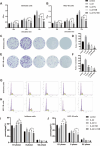Interleukin-22 promotes endometrial carcinoma cell proliferation and cycle progression via ERK1/2 and p38 activation
- PMID: 39690293
- PMCID: PMC12048457
- DOI: 10.1007/s11010-024-05179-7
Interleukin-22 promotes endometrial carcinoma cell proliferation and cycle progression via ERK1/2 and p38 activation
Abstract
Endometrial carcinoma (EC) is one of the most common gynecological malignant tumors, but its underlying pathogenic mechanisms are largely obscure. Interleukin-22 (IL-22), one cytokine in the tumor immune microenvironment, was reported to be associated with carcinoma progression. Here, we aimed to investigate the regulation of IL-22 in endometrial carcinoma. Enzyme-linked immunosorbent assay (ELISA) analysis of IL-22 was done in 27 controls and 51 patients with EC. We examined the proliferative potential, cycle progression, and signaling pathways modulated by IL-22 in EC cells. Western blot analysis was performed to investigate the expression of proliferative and cycle-related proteins in EC cells. The effect of IL-22 mediated by interleukin-22 receptor alpha 1 (IL-22RA1) was examined using cell transfection with small interfering RNA (siRNA). In addition, a xenograft tumor model was performed to assess the effect of IL-22 in vivo. We demonstrated significant up-regulation of serum IL-22 concentrations in EC patients (42.59 ± 23.72 pg/mL) compared to the control group (27.47 ± 8.29 pg/mL). High levels of IL-22 concentrations appear to correlate with malignant clinicopathological features of EC. Treatment with IL-22 promoted cell proliferation and G1/S phase progression in Ishikawa and HEC-1B cells. Western blot analysis revealed that c-Myc, cyclin E1, cyclin-dependent kinase (CDK)2, cyclin D1, CDK4, CDK6, p-extracellular signal-regulated kinase1/2 (p-ERK1/2), and p-p38 were highly expressed in EC cells exposed to IL-22. Moreover, in the EC mice model, we found that giving exogenous IL-22 increased tumor volume and weight. Immunohistochemistry showed that intra-tumor Ki-67 expression was up-regulated upon IL-22 treatment. The IL-22-mediated changes in cell proliferation, cycle progression, and protein expression can be effectively inhibited by the ERK1/2 inhibitor U0126 and the p38 inhibitor SB202190. In addition, the role of IL-22 in EC is receptor-dependent. Our findings suggest that IL-22 promotes endometrial carcinoma cell proliferation and G1/S phase progression by activating ERK1/2 and p38 signaling. Therefore, IL-22 may represent a potential therapeutic target for the treatment of endometrial carcinoma.
Keywords: Cycle progression; Endometrial carcinoma; Interleukin-22; MAPKs; Proliferation.
© 2024. The Author(s).
Conflict of interest statement
Declarations. Conflict of interest: Conflict of interest the authors declare no conflict of interest. Ethical approval: The study was conducted in accordance with the Declaration of Helsinki, and approved by the Institutional Review Board of Tianjin Medical University General Hospital (protocol code IRB2021-KY-356; approved December 24, 2021). The animal study protocol was approved by the Institutional Review Board of Tianjin Medical University General Hospital (protocol code IRB2021-DWFL-422; approved December 24, 2021). Consent to participate: Informed consent was obtained from all individual participants included in the study. Consent to publication: The authors affirm that human research participants provided informed consent for publication of Tables 1 and 2.
Figures






References
MeSH terms
Substances
Grants and funding
LinkOut - more resources
Full Text Sources
Research Materials
Miscellaneous

